|
|
VO2 Thermochromic Smart Window: Status, Challenges and Prospects
XU Fang, JIN Pingshi, LUO Hongjie, CAO Xun
2021 Vol. 36 (10): 1013–1021
 Abstract
Abstract(
1642 )
 HTML
HTML(
99)
 PDF
PDF(12476KB)(
2227
)
Vanadium dioxide (VO2), as a transition metal oxide, has thermochromic property, which undergoes metal to insulator transition (MIT) in response to external temperature changes, and is accompanied by numerous changes in physical property. It has attracted widespread attention in the field of smart windows. In recent years, research on the preparation method of VO2, the phase change mechanism, and the improvement of optical performance are quite rich. However, practical applications still face technical bottlenecks and challenges such as higher intrinsic transition temperature (Tc), lower luminous transmittance (Tlum), insufficient solar modulation ability (ΔTsol), nonideal metastability and durability, and uncomfortable color for human eyes (brownish yellow). At present, there are many researches related to the improvement of the performance of VO2 itself owing to its insufficient optical property, and general methods for improving its performance such as elements doping, multilayer film structure design, and microstructure design have been widely adopted. This review summarizes the general performance improvement strategies of VO2 film, and highlights the latest research progress of VO2-based smart window service performance, low-temperature flexible preparation and color modulation in practical applications. Future development trends are also discussed in terms of skin comfort and environmental friendliness.

|
|
|
Application of Second Harmonic Generation in Characterization of 2D Materials
XIA Fangfang, WANG Fakun, HU Hailong, XU Xiang, LI Yang, ZHAI Tianyou
2021 Vol. 36 (10): 1022–1030
 Abstract
Abstract(
1979 )
 HTML
HTML(
109)
 PDF
PDF(8432KB)(
2596
)
As an important branch of nonlinear optics, second harmonic generation (SHG) is becoming one of the most important means to characterize crystal structure. Among various methods of characterization, because of nondestructive detection, high stability, tunability, ultrafast response, polarization sensitivity, versatility and simplicity, SHG is widely used to characterize the structure of two-dimensional (2D) materials. It provides important information for the physical properties and functional applications of 2D materials, as well as greatly promotes the rapid development of basic research on 2D materials. Here, the current state of the art focuses on the recent research work of SHG in 2D material structure characterization. Firstly, the principle of the second harmonic generation is briefly introduced. Then, the second harmonic generation device with femtosecond laser connected to confocal Raman spectrometer is taken as an example to present the mechanism of SHG. Afterwards, the applications of SHG are demonstrated in the thickness of interlayer stacking of 2D materials, the stacking angle between different layers of 2D materials, the grain boundary and the crystal orientation of monolayer 2D materials. The second harmonic intensity is used as a direct and sensitive means to monitor the strain amplitude, and the SHG signal changes are used to track defects in materials. Meanwhile, the importance of multi-dimensional correlation analysis of second harmonic generation, Raman spectroscopy and photoluminescence in comprehensive and in-depth characterization of materials is also explored. Finally, the potential research directions and prospects based on SHG in material characterization in the future is prospected.
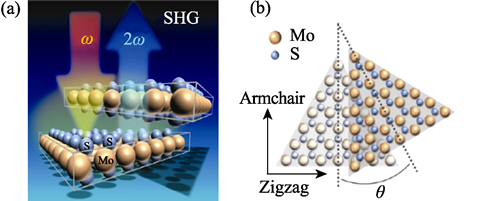
|
|
|
Methylnaphthalene Pitch-based Ordered Mesoporous Carbon: Synthesis and Electrochemical Properties
TANG Jiawei, WANG Yongbang, MA Cheng, YANG Haixiao, WANG Jitong, QIAO Wenming, LING Licheng
2021 Vol. 36 (10): 1031–1038
 Abstract
Abstract(
555 )
 HTML
HTML(
28)
 PDF
PDF(3123KB)(
987
)
Ordered mesoporous carbon was synthesized by liquid impregnation, using polymerized pitch prepared from 1-methylnaphthalene through thermal bromination with dehydrobromination as precursor and mesoporous silica SBA-15 as template. Microstructure and electrochemical properties of mesoporous carbon were characterized. It was found that the optimal preparation conditions were template/pitch mass ratio of 1:1, carbonization temperature of 900 ℃, and heating rate of 1 ℃·min-1. The optimal sample exhibits highly ordered two-dimensional hexagonal channels, with specific surface area of 675 m2·g-1, pore volume of 1 cm3·g-1, and pore diameter concentrated at about 3.84 nm. The Li-S batteries with this mesoporous carbon as the sulfur host showed excellent electrochemical performance. After 300 cycles, the specific discharge capacity and capacity retention were 688 mAh·g-1 and 67.1% at a current density of 0.2C (1C=1675 mA·g-1), respectively, while the specific capacity could reach 556 mAh·g-1 at a current density of 3C.

|
|
|
Construction and Photocatalytic Performance of 3D Hierarchical Pore rGO/TiO2 Composites
Li Cuixia, SUN Huizhen, JIN Haize, SHI Xiao, LI Wensheng, KONG Wenhui
2021 Vol. 36 (10): 1039–1046
 Abstract
Abstract(
468 )
 HTML
HTML(
22)
 PDF
PDF(4545KB)(
761
)
Utilizing polystyrene (PS) microspheres as templates, and graphene oxide (GO) and tetrabutyl titanate (TBT) as raw materials, 3D hierarchical pore rGO/TiO2(PS) composites were fabricated by Sol-Gel method based on multiple coordination reactions. The structure and morphology of 3D hierarchical pore rGO/TiO2(PS) composites were characterized, and the effects of PS addition on crystal structure, microscopic morphology and photocatalytic performance of rGO/TiO2 composites were studied. Under simulate ultraviolet light and visible light irradiation, tetracycline hydrochloride (TTCH) using as the target pollutant, the photocatalytic performance of 3D hierarchical pore rGO/TiO2(PS) composites prepared with different PS addition was evaluated. Under simulated visible light irradiation, the 3D hierarchical pore rGO/TiO2(5wt%PS) composites were subjected to multiple recycling tests. The results show that the rGO/TiO2(PS) composites have a 3D hierarchical pore bulk structure. As the reinforcing phase of matrix, GO keeps stability of multistage pore rigid skeleton structure through Ti-O-C bond. Furthermore, the introduction of PS increases the specific surface area of the rGO/TiO2(PS) composites. The 3D hierarchical pore rGO/TiO2(7wt%PS) composite has the highest adsorption efficiency for TTCH, while the 3D hierarchical pore rGO/TiO2(5wt%PS) composite has the highest photocatalytic activity and stability, which photocatalytic efficiency still reaches 81.02% after 4 cycles of recycling tests; the best addition amount of template PS is 5wt%.

|
|
|
DFT Calculation of NO Adsorption on Cr Doped Graphene
HE Junlong, SONG Erhong, WANG Lianjun, JIANG Wan
2021 Vol. 36 (10): 1047–1052
 Abstract
Abstract(
527 )
 HTML
HTML(
23)
 PDF
PDF(1390KB)(
593
)
Graphene has recently become one of the best candidates for ultrasensitive gas detector, due to its huge specific surface area and good conductivity of heat and electricity. In this study, a density functional theory (DFT) calculation is proposed to explore NO adsorption on graphene and Cr doped graphene. Compared with electronic structures of the two systems, it is found that the Cr substitution significantly enhances the adsorption behavior of NO molecules (adsorption energy being increased to -1.58 eV), while more electrons transfer from the substrate to the adsorbate (0.143 e). Therefore, this Cr doped graphene is expected to be an excellent candidate for sensing NO gas.
|
|
|
Fe-Co-K/ZrO2 Catalytic Performance of CO2 Hydrogenation to Light Olefins
LIU Qiang, DING Jie, JI Guojing, HU Juanmin, GU Hao, ZHONG Qin
2021 Vol. 36 (10): 1053–1058
 Abstract
Abstract(
528 )
 HTML
HTML(
32)
 PDF
PDF(1356KB)(
997
)
In recent years, with the consumption of fossil resources and the large amount of CO2 emissions, the energy crisis and the greenhouse question become deeply serious. The direct synthesis of olefins by CO2 hydrogenation with iron-based catalysts is one of the best ways to achieve CO2 reduction. In this study, zirconia (ZrO2)-supported iron-cobalt catalyst (Fe-Co/ZrO2) and ZrO2-supported iron-cobalt-potassium catalyst (Fe-Co-K/ZrO2) were prepared by impregnation method, which were used for CO2 hydrogenation to light olefins (C2=-C4=), and the effect of K on the catalytic activity were investigated emphatically. At the condition of 300 ℃ and 1.5 MPa, the activity test show that addition of K increases the CO2 conversion from 40.8% to 44.8%, improves the selectivity of light olefins from 0.23% to 68.5%, and raises the stability of catalytic performance. The characterization results show that introduction of K improves electron cloud density of the iron species, enhances adsorption strength of the Fe to CO2, promotes the formation of iron carbide, and facilitates direct dissociation of CO2 after adsorption on Fe species, thus boosts the performance of CO2 hydrogenation to light olefins.
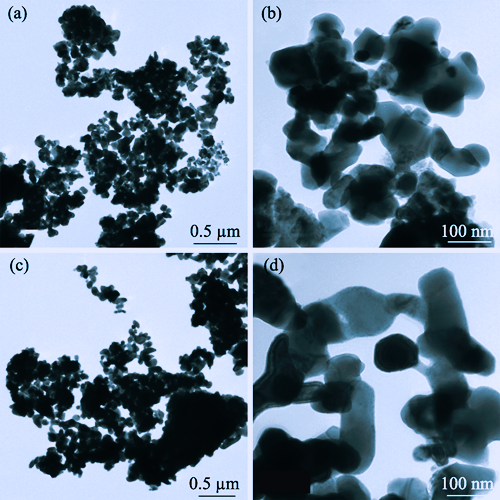
|
|
|
Structure Change and Phase Transition Distribution of YSZ Coating Caused by CMAS Corrosion
FAN Wenqi, SONG Xuemei, HUANG Yiling, CHANG Chengkang
2021 Vol. 36 (10): 1059–1066
 Abstract
Abstract(
463 )
 HTML
HTML(
17)
 PDF
PDF(12972KB)(
978
)
To study the microstructure changes and phase transitions of different depth areas in the YSZ coating caused by corrosion of the calcium magnesium aluminum silicate (CMAS) at high temperature, scanning electron microscope (SEM) and an X-ray diffractometer (XRD), energy-dispersive X-ray spectroscope (EDS) and electron backscatter diffraction (EBSD) were used to characterize and analyze the YSZ coating before and after corrosion. The results show that YSZ coating after high-temperature CMAS corrosion exhibits spalling, dense, light dense and obvious layered structure from top to bottom. The melting/recrystallization phenomenon occurs on the top of the YSZ coating, which causes a phase transition from initial t-ZrO2 particles to m-ZrO2 particles and the degree of the phase transition decreasing from top to bottom. It is also found that the CMAS-induced phase transition mainly occurs at the grain boundaries since the molten CMAS is easier to penetrate and erode along the grain boundaries of the coating.
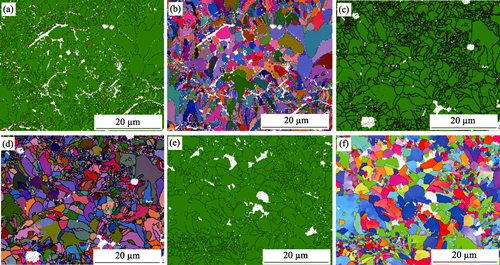
|
|
|
Predicting Thermomechanical Properties of MgAl2O4 Transparent Ceramic Based on Bond Valence Models
FENG Mingxing, WANG Bin, XU Pengyu, TU Bingtian, WANG Hao
2021 Vol. 36 (10): 1067–1073
 Abstract
Abstract(
278 )
 HTML
HTML(
14)
 PDF
PDF(631KB)(
561
)
Spinel-type ceramics have great application prospects owing to their excellent thermomechanical properties in the field of high-temperature structural materials. In this study, a new approach that combined bond valence models with high-temperature mechanical theoretical characterization models was established to predict the high-temperature thermomechanical properties of spinel-type ceramics based on temperature-dependent crystal structure. Further more, the relationship between crystalline structure and high-temperature properties was clarified. The high-temperature fracture strength and fracture toughness of MgAl2O4 transparent ceramic, were predicted by this approach, which agreed well with the experimental values. It is shown that the ratio of cation inversion, hardness and bulk modulus of chemical bonds in MgAl2O4 vary significantly with temperature around 800 ℃. However, due to coupling effect of the coordinated polyhedra, the temperature-dependent cation inversion can hardly affect the high-temperature thermomechanical properties of MgAl2O4 transparent ceramic.

|
|
|
FePS3 Nanosheets: Preparation and Potential in Photothermal-photodynamic Therapy
YANG Mai, ZHU Min, CHEN Yu, ZHU Yufang
2021 Vol. 36 (10): 1074–1082
 Abstract
Abstract(
472 )
 HTML
HTML(
13)
 PDF
PDF(1506KB)(
874
)
Phototherapy, a tumor therapeutic modality, has been widely studied due to its advantages of minimal invasiveness, low side effect, and high therapeutic efficacy. However, single phototherapy cannot achieve complete tumor elimination. Recently, the emerging two-dimensional nanomaterials have attracted great attention in the field of phototherapy. Here, FePS3 nanosheets were prepared, and then its phototherapeutic properties were investigated. The bulk FePS3 was synthesized by a high-temperature solid-phase method and FePS3 nanosheets were obtained by an ultrasonic-assisted liquid phase exfoliating method. The nanosheets displayed particle morphology with average hydrated size of less than 200 nm (153 nm in average), performed photothermal conversion efficiency of 19.7% under 1064 nm laser irradiation, and generated reactive oxygen species under 660 nm laser irradiation. Cell experiment results showed that FePS3 nanosheets had excellent photothermal and photodynamic therapeutic effects. Therefore, FePS3 nanosheets can be used as both photothermal agent and photosensitizer to achieve combined photothermal-photodynamic therapy for treating tumors, which shows great application potential.
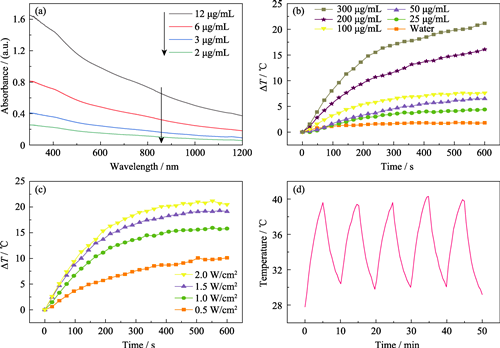
|
|
|
Co-modification of Biochar and Bentonite for Adsorption and Stabilization of Pb2+ ions
XIAO Yao, WU Zhongjie, CUI Mei, SU Rongxin, XIE Lianke, HUANG Renliang
2021 Vol. 36 (10): 1083–1090
 Abstract
Abstract(
440 )
 HTML
HTML(
25)
 PDF
PDF(2415KB)(
743
)
Heavy metals can seriously endanger human health and the ecological environment due to their toxicity, persistence, and bioaccumulative nature. In this study, an alkali-modified biochar-bentonite composite (CaO-Bent-CB) was prepared by alkali modification of corncob residues and bentonite mixture by calcium chloride and calcination at high temperature under anaerobic conditions. The CaO-Bent-CB composite has a specific surface area of 441.1 m2/g, which is significantly higher than CB (132.7 m2/g) and CaO-CB (177.2 m2/g). Meanwhile, the adsorption perfermance of CaO-Bent-CB to lead ions in water was evaluated. The results showed that the removal efficiency reached 98% after 6 h-adsorption, and the adsorption capacity was 109.6 mg/g when the concentration of lead ion was 120 mg/L, the weight ratio of bentonite to corncob residues was 1:5, and the dosage was 1 g/L. The adsorption capacity of CaO-Bent-CB was higher than that of CB (13.4 mg/g), bentonite (72.9 mg/g) and CaO-CB (86.9 mg/g). Moreover, the lead ion contaminated soil was stabilized by CaO-Bent-CB. When the concentration of lead ion in soil is 2200 mg/kg, and the loading of CaO-Bent-CB is 8% of soil, the concentration of lead ions in acid leachate (H2SO4-HNO3, pH=3.2, 12 h-soaking) is 4.5 mg/L, which is lower than the standard value of hazardous waste identification (5 mg/L). The results show that CaO-Bent-CB has a great potential in the water treatment and heavy metals removal in soil.
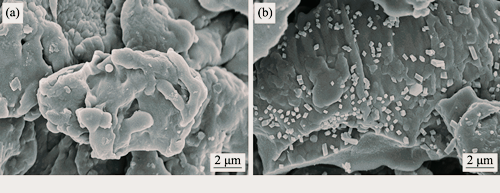
|
|
|
Hydrothermal Preparation and Characterization of Zn, Si, Mg, Fe Doped Hydroxyapatite
SONG Keke, HUANG Hao, LU Mengjie, YANG Anchun, WENG Jie, DUAN Ke
2021 Vol. 36 (10): 1091–1096
 Abstract
Abstract(
566 )
 HTML
HTML(
19)
 PDF
PDF(7366KB)(
876
)
Doping of trace elements is an effective way to endow hydroxyapatite with more biological functions. But the behaviors of different element doping remained to be further revealed. Here, nine kinds of hydroxyapatite particles containing zinc, silicon, magnesium, iron, manganese, copper, strontium, selenium, and cobalt, respectively, were prepared by parallel hydrothermal synthesis, and their physicochemical properties were studied. The results show that the morphology and crystal growth direction of hydroxyapatite particles are significantly changed, while the phase composition is maintained. The peak intensity of (211) and (112) plane diffraction peaks decreased, accompanied by decreased crystallinity. Analysis results show that the actual doping efficiency obeys the tendency of manganese > zinc > magnesium > iron (trivalent) > strontium > cobalt > copper > selenium > silicon. Among these elements, doping amounts of Mn, Zn and Mg are higher, because their ion radii are closed to that of Ca 2+. The low doping efficiency of copper is caused by its complexation with ammonia in synthetic solution, while silicon and selenium are caused by different geometry and charge of SiO32-, SeO32- from that of PO43-. This study reveals the reasonable relationship between doping behavior and ion characteristics, providing a useful reference for design and development of functionalized hydroxyapatite.
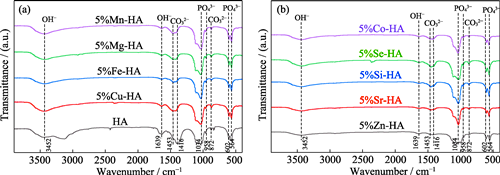
|
|
|
Influence of Al Content on Oxidation Resistance of Phase-pure Ti2AlC under Simulated Loss-of-coolant Accident Conditions
LEI Yiming, ZHANG Jie, BAI Guanghai, ZHANG Yanwei, WANG Xiaohui, WANG Jingyang
2021 Vol. 36 (10): 1097–1102
 Abstract
Abstract(
375 )
 HTML
HTML(
11)
 PDF
PDF(1077KB)(
785
)
To tailor Ti2AlC coatings for the applications in accident tolerant fuels, the oxidation of near-stoichiometric and Al-lean Ti2AlC was investigated in Ar-41% H2O atmosphere in 1000-1200 ℃. The oxidation kinetics of phase-pure Ti2AlC in high-temperature water vapor varied from parabolic to linear rate law with Al content decreasing. Insufficient Al content could not sustain the growth of continuous alumina scales, resulting in formation of thick unprotective TiO2-based scales. The formation of thin and protective Al2O3 scale for Ti2AlC with stoichiometric composition effectively inhibited the inward diffusion of water vapor. For the application of protective coatings on Zr-based cladding, stoichiometric Ti2AlC is expected to protect cladding from fast oxidation and improve the accident tolerance in the current light water reactors.
|
|
|
Optimizing Microstructure and Properties of SiCf/SiC Composites Prepared by Reactive Melt Infiltration
ZHANG Junmin, CHEN Xiaowu, LIAO Chunjin, GUO Feiyu, YANG Jinshan, ZHANG Xiangyu, DONG Shaoming
2021 Vol. 36 (10): 1103–1110
 Abstract
Abstract(
841 )
 HTML
HTML(
44)
 PDF
PDF(12187KB)(
1654
)
Reactive melt infiltration (RMI) is one of the most effective methods to prepare highly dense ceramic matrix composites. The melt infiltration and the formation of composites are mainly determined by the pore structure of preforms. Here, SiC fiber reinforced SiC matrix composites (SiCf/SiC) were prepared by infiltrating Si melt into carbon-contained preforms with various pore structures. Effects of pore structure on the melt infiltration and received SiCf/SiC composites were investigated. The results indicated that the preforms with more homogeneous pore size could lead to more sufficient melt infiltration, and also resulted in fewer residual pores and better mechanical properties in the composites. This study is expected to provide important guidance for the pore structure regulation in the fabrication of RMI-composites.
|
|
|
Influence of SiC Nanowires on the Damage Evolution of SiCf/SiC Composites
LI Longbin, XUE Yudong, HU Jianbao, YANG Jinshan, ZHANG Xiangyu, DONG Shaoming
2021 Vol. 36 (10): 1111–1117
 Abstract
Abstract(
431 )
 HTML
HTML(
17)
 PDF
PDF(6742KB)(
868
)
SiC fiber (SiCf)/SiC composites were modified by SiC nanowires (SiCnw) grown in-situ on SiC fiber to obtain hierarchical structure. Effects of this hierarchical structure on the properties of composites, such as microstructure, fracture strength and damage evolution, were evaluated. Results show that the introduction of SiCnw significantly improves the matrix infiltration efficiency. SiCnw and BN-coated SiCnw reinforced SiCf/SiC composites acquire better performance in bending tests by comparison with conventional SiCf/SiC. SiCnw coated by BN interphase obviously enhances the strength owing to weak-bonded interface. Besides, results of acoustic emission and Coated Vickers Hardness Impresses reveal that SiCnw delay early damage evolution at early state and mainly make contribution to hindering and bridging of microcracks, which is further enhanced by BN-coated SiCnw.
|
|
|
Fine-grained Ce,Y:SrHfO3 Scintillation Ceramics Fabricated by Hot Isostatic Pressing
ZHU Danyang, QIAN Kang, CHEN Xiaopu, HU Zewang, LIU Xin, LI Xiaoying, PAN Yubai, MIHÓKOVÁ Eva, NIKL Martin, LI Jiang
2021 Vol. 36 (10): 1118–1124
 Abstract
Abstract(
395 )
 HTML
HTML(
15)
 PDF
PDF(1712KB)(
729
)
Ce:SrHfO3 ceramics possess a strong stopping power to high-energy rays due to their high density and high effective atomic number. However, it is difficult to obtain transparent Ce:SrHfO3 ceramics via traditional sintering method because of its orthogonal structure. In this work, Ce,Y:SrHfO3 ceramics were prepared by long-time vacuum sintering and short-time vacuum pre-sintering combined with hot isostatic pressing (HIP). The Ce,Y:SrHfO3 powders with a pure phase and a mean particle size of 152 nm were prepared by calcining at 1200 ℃ for 8 h using metal oxides and carbonates. The Ce,Y:SrHfO3 ceramics vacuum-sintered at 1800 ℃ for 20 h are opaque with an average grain size of 28.6 μm, while those prepared by the two-step sintering method show good optical transmittance. The evolution of the microstructure in the process of densification was analyzed in detail, and the influence of the pre-sintering temperature on the density, microstructure and optical transparency of Ce,Y:SrHfO3 ceramics was studied. The Ce,Y:SrHfO3 ceramics pre-sintered at 1500 ℃ for 2 h with HIP post-treatment at 1800 ℃ for 3 h have the highest in-line transmittance of 21.6% at 800 nm with a far smaller average grain size of 3.4 μm. Under X-ray excitation, the Ce3+ 5d-4f emission of Ce,Y:SrHfO3 ceramics was observed at 400 nm, and the XEL integral intensity is 3.3 times higher than that of Bi4Ce3O12 (BGO) crystals. The light yield of the Ce,Y:SrHfO3 ceramics is approximately 3700 ph/MeV with the shaping time of 1 μs. Good optical quality and scintillation performance of Ce,Y:SrHfO3 ceramics may expand the application range and potential in the field of scintillation detection.

|
|